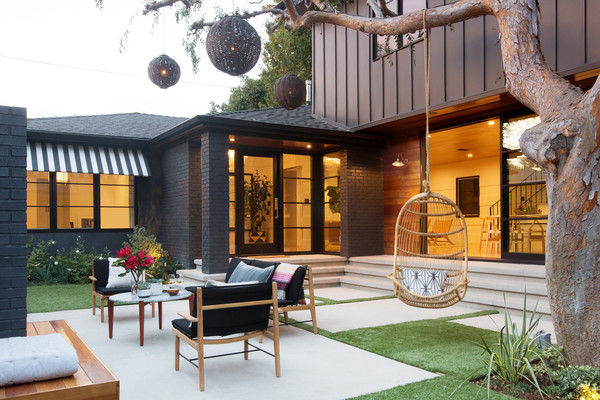
It may be tempting to choose the most expensive roofing material, but you should not spend too much on roof extensions. It is unlikely anyone will notice the extension and you won't be able to see it from the outside. Before you go ahead with your home improvement project, think about what it will do to your home. It's your roof. Make wise choices. You should be realistic about your financial situation if you plan to expand your living space.
Before you go ahead with your roof extension, remember that it'll dramatically change the look of your home. You should consider the final look you desire before you decide to extend your roof. Flat roofing is an option if your extension would like to have a floating effect. To cover the top of your new extension, use a parapet. People who want to give their homes a more fashionable look can opt for a flat roof.

You'll need to consider how much extra space you'll need. You can add an additional room to your home by adding a roof. However, you need to ensure you have enough space for it. For this purpose, a pitched roof is an option. A flat roof is also practical, but you should make sure that it fits your property. Pitch roofing is not right for every home.
To extend a flat roof, it is important to assess the load-bearing capability of your home. You will need a stronger roof if your roof is weak. This should be taken into consideration when you are choosing a design/build company. You have the option to choose the style or colour that best suits your home's architecture. A white roof is an option if you are looking for a conservatory.
Pitch roofs are the most common type of roof extensions. A pitched roof is not only cost-effective, but also very effective in extreme weather conditions. A single-sloped roofing is more appropriate for smaller extensions than a standard flat-roofed roof. Although its simplicity is a plus, it is not recommended for larger structures. It is not compatible with all roof styles. Flat-roofed houses should not be used as loft conversions.

In addition to the cost, roof extensions are a good way to increase the size of your home. A pitched roof will increase the size of your home by adding more space. If you don’t want the cost of a house extension to be as high, you could also opt for a gable roofing option. A flat-roofed extension's cost will vary depending on your budget, your tastes, and the aesthetics of the house.
FAQ
How Much Does It Cost To Renovate A House?
The cost to renovate a building depends on its material and complexity. Some materials like wood need additional tools, like saws or drills, while others like steel don't. The price of renovations depends on whether you hire a contractor to do the job or if you are willing to do the work yourself.
Home improvement projects cost on average $1,000 to $10,000. The average cost of home improvement projects would be between $5,000 and $25,000. On the other hand, if you decide to do the entire task yourself then the total cost could reach up to $100,000.
It is important that you are aware of the many factors that affect the final price of renovations. The cost of renovation depends on the material used (e.g. Brick vs. concrete, the project's size, the number and duration of workers, etc. These are important considerations to remember when estimating total renovation cost.
Is it cheaper to build a new house or remodel an old one?
If you're thinking about building a new home, there are two options for you. The other option is to purchase a prebuilt home. These homes are ready to be moved into and have already been built. You could also build your dream home. With this option, you'll need to hire a builder to help you design and build your dream home.
It all depends on how much you spend designing and planning the home. It will take more effort to build a custom-built home because you'll be required to do most construction work. But you can choose the materials you want and where you want them to be placed. It might be easier to find a contractor that specializes in custom-built homes.
A new house is generally more expensive than a home that has been renovated. That's because you'll pay more for the land and any improvements you make to the property. In addition, you will need to pay permits and inspections. The average price difference between a new home and one that has been renovated is between $10,000 and $20,000.
Do I require permits to renovate a house?
Yes. Permits will be required for any home-improvement project. In most cases, you will need both a plumbing and building permit. A zoning permit is also required depending on the type and extent of work you are performing.
Is it better to finish floors or walls first?
The best way for any project to get started is to decide what you want. It is important to consider how you will use the space, who it will be used for and why. This will help you decide if you should go for flooring or wall coverings.
If you have decided that you want to create an open plan kitchen/living area then you may choose to install flooring first. If you have chosen to make this room private then you could opt for wall coverings instead.
Statistics
- ‘The potential added value of a loft conversion, which could create an extra bedroom and ensuite, could be as much as 20 per cent and 15 per cent for a garage conversion.' (realhomes.com)
- According to the National Association of the Remodeling Industry's 2019 remodeling impact report , realtors estimate that homeowners can recover 59% of the cost of a complete kitchen renovation if they sell their home. (bhg.com)
- A final payment of, say, 5% to 10% will be due when the space is livable and usable (your contract probably will say "substantial completion"). (kiplinger.com)
- Design-builders may ask for a down payment of up to 25% or 33% of the job cost, says the NARI. (kiplinger.com)
- It is advisable, however, to have a contingency of 10–20 per cent to allow for the unexpected expenses that can arise when renovating older homes. (realhomes.com)
External Links
How To
How do I plan a whole house remodel?
Planning a whole-house remodel requires planning and research. Before you start your project, there are many factors to consider. It is important to determine what type of home improvements you are looking to make. There are several categories you can choose from, such as bathroom, kitchen, bedroom, living area, and so on. Once you've chosen the category you want, you need to decide how much money to put towards your project. If you are new to working in homes, budget at least $5,000 for each room. If you have experience, you may be able to manage with less.
Once you know how much money your budget allows you to spend, then you will need to decide how big a job it is you are willing to take on. If you have only enough money to remodel a small kitchen, you may not be able add new flooring, countertops, or paint the walls. You can do almost everything if you have enough cash for a full-scale kitchen renovation.
Next, you need to find a contractor who is experienced in the type project that you want. This will guarantee quality results, and it will save you time later. After finding a good contractor, you should start gathering materials and supplies. You may need to purchase everything from scratch depending on the size and scope of your project. However, it is possible to find everything you need in a variety of shops that sell premade items.
After you've gathered all the supplies you need, it's time to begin making plans. First, you'll want to draw up a rough sketch of where you want to place furniture and appliances. Then you will design the layout. It is important to allow for electrical and plumbing outlets. You should also place the most frequently used areas closest to the front door, so visitors have easy access. The final step in your design is to choose colors and finishes. In order to avoid spending too much money, stick to neutral tones and simple designs.
Now that your plan is complete, it's time you start building! Before you begin any construction, make sure to verify your local codes. Some cities require permits while others allow homeowners to build without one. First, remove all walls and floors. The next step is to lay plywood sheets on your new flooring. Next, nail or screw pieces of wood together to form the frame that will house your cabinets. You will attach doors or windows to the frame.
You'll need to finish a few final touches once you're done. You will likely need to cover exposed wires and pipes. You will need to use tape and plastic sheeting for this purpose. You'll also want to hang pictures and mirrors. Keep your work area tidy and clean at all times.
These steps will ensure that you have a beautiful and functional home, which will save you tons of money. Now that you are familiar with how to plan a whole home remodel project, it is time to get started.